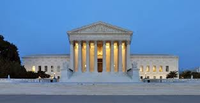
Recognizing the possibility that this might occur, the Founders’ only solution was to institute lifetime appointments to federal courts that would transcend the tenure of any given president or congress. That was in an era in which few citizens had ever left their own state, learned a foreign language, earned a university or law school diploma or indeed subjected themselves to the competitive aspects of a society of 300 million people, and when the primary criteria to be considered for a court seat were that one be adult, white, male and acceptable to the current power structure. In the modern world, that solution is inadequate and has often resulted in the appointment of relative non-entities to the Supreme Court. There are probably much better ways to manage a court system in the modern era.
Imagine a “Supreme Court System” to replace the current arbitrary grouping. The members of the court hearing any given case would be drawn from among a set of eligible justices on the various appellate courts -- from which many of the Supremes are now drawn anyway -- assigned at random. They need not all be in the same place, as they could share everything, both written and oral, by telecommunication, as most appellate cases are not heard but read, with oral argument being only a supplementary part of the review and often omitted. Where used, oral argument can be presented over the Internet, as was done in the recent Hawaii-based hearings on travel restrictions.
There are currently 169 members of the appellate circuits. If that number were increased, let’s say to 200, or even doubled, there would be adequate judicial time to hear the cases now before the Supreme Court (only a tiny minority of cases are ultimately resolved by the SC). Each case could be examined by a group of nine selected randomly (or perhaps five or seven for cases not involving constitutional or other truly national issues) from among the 200. For quality control, if necessary, eligibility for SC cases could be limited to the senior half of the appellate justices, whereby the qualifications of the justices on any given case would be at least comparable to the current politically selected jurists. Randomization effects would diminish partisan influence.
This approach could also make more cases suitable for SC review, giving both fairness and finality to many cases now declined by the SC. The SC could also be extended to a full work year; the current arrangement is determined in part by the awful summer weather in DC, which should hardly be part of a decision process that can involve life and death.
The Constitution does not prohibit such a change. It would be well within the law to change the role of the Chief Justice to one of administration and assignment of the five, seven, nine, etc., justices to individual cases (the Constitution leaves rules of court structure and management to Congress). The cost of the courts might rise somewhat, but the increased efficiencies and the reduced time and travel required of litigants, lawyers and judges would offset much of the increase, and litigants would be more likely able to get on with their lives. The suggested changes would also in a heartbeat increase the probable socioeconomic diversity of the members of the court hearing any given case, making the justices more like peers than superiors of the litigants.
Such a change should be acceptable across political lines. Both conservatives and liberals have been heard to complain about decisions being made in “far off Washington DC” that could be made closer to the action.
We are not well served by the current politically charged court. It is time to review the implementation of Article III of the Constitution and bring the Supreme Court into the 21st Century.
Copyright © 2017 A. Rees Clark